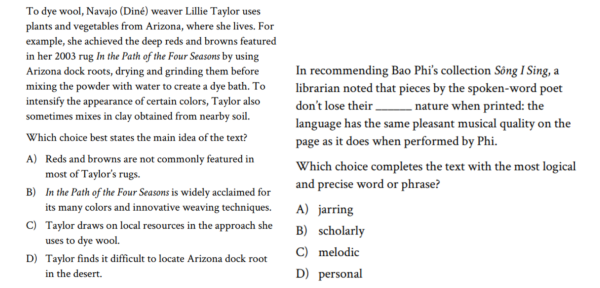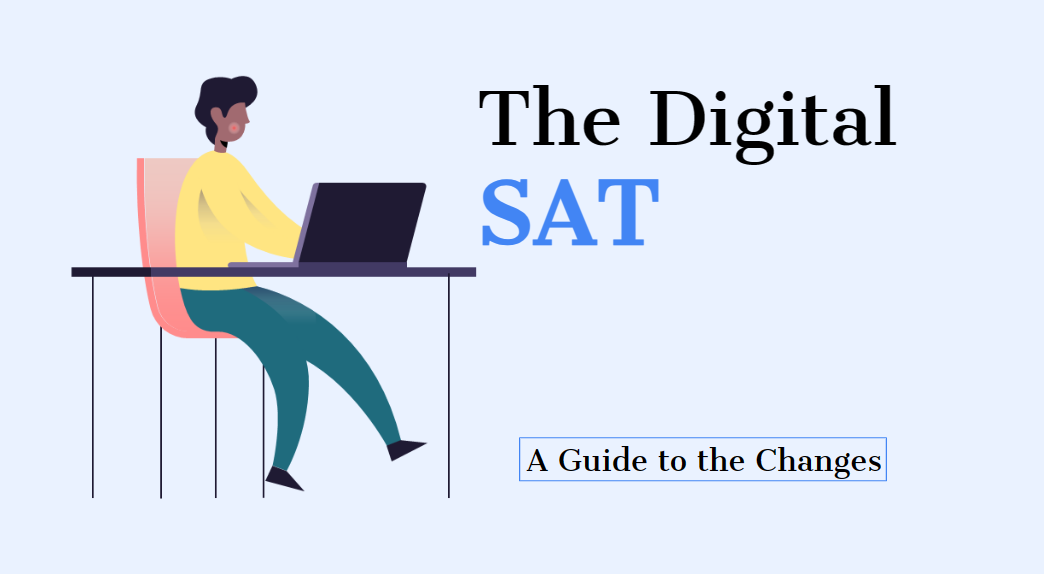If you are an upperclassman, you likely received a form to decide between taking the in-school ACT or SAT. While both tests are valued the same by colleges, many students have trouble deciding which to take, as one test is often better suited for you than the other. However, in March of 2024, the SAT is making significant changes that may lead it to become more popular than the ACT.
What is Changing?
A Digital Test
The SAT will be fully digital, meaning the test will no longer be on paper. Prior to test day, students must download Bluebook™, the SAT’s digital application, and complete an exam setup 1-5 days before the test. This software works on school-owned or personal laptops (MacOS and Windows), iPads, and Chromebooks. The Bluebook system will have a built-in graphing calculator and timer, but students can still choose to bring their own from home. Students can also find four full-length practice tests on Bluebook to prepare for the digital SAT and practice tests for the PSATs. If a student does not have access to a device, students can request to borrow a device from the College Board.
The Structure
The Reading and Writing and Language tests will now be a single Reading and Writing test. The new SAT will also combine the math sections, allowing students to use calculators for the entire math test. Both tests are split into two modules. Students can move between questions in a module until time expires, but they can not move ahead or return to previous modules.
The Amount of Time
The SAT will be shortened from three hours to two hours and 14 minutes. Students were previously allotted 65 minutes for the Reading Test, 35 minutes for the Writing and Language, and 80 minutes for the Math Test (55 for the calculator section and 25 for the non-calculator). In the new version, students will have 64 minutes to complete the Reading and Writing test, divided into two 32-minute modules, and 70 minutes to complete the Math section, divided into two 35-minute modules.
The Number of Questions
Previously, the SAT consisted of 154 questions. The new digital SAT will have 98. The old Math test had 58 questions: 19 (33%) on the Heart of Algebra (linear equations, functions, and inequalities), 17 (29%) on Problem Solving and Data Analysis (ratios and percentages), 16 (27.5%) on Passport to Advanced Math (manipulating complex equations), and 6 (10%) additional questions (geometry, trigonometry, radian measure, and complex numbers). The new Math test has 44 questions: 13-15 (35%) on Algebra, 13-15 (35%) on Advanced Math (nonlinear equations and functions and equivalent expressions), 5-7 (15%) on Problem-Solving and Data Analysis, and 5-7 (15%) on Geometry and Trigonometry (triangles, area, volume, and circles). The main changes within the Math test are that there are fewer problem-solving and data-analysis questions and that the additional questions now have a proper focus. The old Reading test had 52 multiple-choice questions under three categories: how the author uses evidence, understanding words in context, and analysis in history and science. In the allotted time, students analyze five passages, ranging between 500 and 750 words, and answer the questions. The old Writing and Language test consisted of 44 multiple-choice questions where students had to recognize and correct grammatical errors and improve the quality of a writer’s message in four 400-450 word passages. The new Reading and Writing test will have 54 questions, with 46% addressing writing skills and knowledge and 54% addressing reading skills and knowledge. The Reading and Writing test will feature shorter reading passages with one question tied to each, rather than answering questions about nine passages. Below are two examples of passages taken from the College Board’s Digital SAT’s Sample Questions and Explanations:

What is the Significance?
This change could be striking in either the SAT’s growth or decline in relevance. The old SAT already relieved pressure off students by providing 43% more time per question than the ACT. The new SAT will increase this percentage, allowing 68% more time per question than the ACT. Another alluring factor is that the test will be done in a shorter time span than the ACT, which takes two hours and 55 minutes. Colleges will continue to value the new SAT the same as the ACT, so taking a shorter test will not hurt students. A blatant significance is that the SAT is moving away from a previous structure they shared with the ACT of reading, synthesizing, and correcting long passages. These shorter passages will attract students who often get distracted or lost in the text. The SAT is known for being better suited for students with strength in English, while the ACT draws those who favor Math and Science. The College Board did not make any changes to attract science students. However, they may be able to attract more math students with their deduction of the no-calculator section and increase in geometry and trigonometry questions. However, the new SAT Math test maintains the student-based response questions, which previously accounted for 22% of the test, while the ACT is solely multiple choice.
Author Thoughts
In my opinion, I believe that the new SAT will be extremely successful as there will be a greater discrepancy between the SAT and the ACT. Like many others, I debated for a great deal of time over which test I should take or take first. If the digital SAT had been available to me in my junior and senior years, I would not have even taken the ACT. I would have been drawn to the one-question per passage feature and the lesser time and fewer questions that the test requires. Overall, I believe that this change was a smart choice for College Board to make, as many colleges are choosing whether to renew their test-optional policies. The shortened, digitized SAT will make it easier for students to take and for them to be proctored.
References
Digital SAT Brings Student-Friendly Changes to Test Experience – Newsroom (collegeboard.org)
The SAT Math Test: Overview (article) | Khan Academy
What to Expect on Test Day – SAT Suite | College Board
How the SAT Is Structured – SAT Suite | College Board
How the Digital SAT Is Structured – SAT Suite | College Board
Digital SAT Device Lending – SAT Suite | College Board
What to Bring on Digital SAT Test Day – SAT Suite (collegeboard.org)
Digital SAT Sample Questions and Explanations (collegeboard.org)
SAT Math Grid-Ins – SAT Suite | College Board
SAT Reading Test Overview – SAT Suite | College Board















